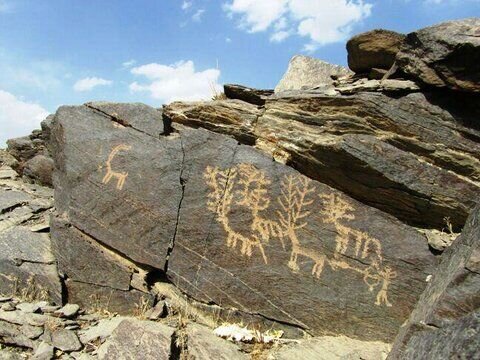Millennia-old petroglyph site distorted by mining operations

TEHRAN– Mining operations have caused perspective distortion in the Teymareh site, which is a heaven for millennia-old petroglyphs at the foot of Zagros mountains, a local tourism official has said.
Twenty years of consecutive mining operations near the ancient site have cluttered the landscape of the Teymareh petroglyphs, Mostafa Qanuni said on Wednesday.
Back in November, a tourism official announced that mining operations were brought to a halt near the Teymareh site.
“A ban has been enforced on mining activities in the neighboring lands of the Teymareh petroglyph site [which is located in Khomein, Markazi province]…. And the legal bar was reached through the efforts of the provincial directorate of cultural heritage, tourism, and handicrafts,” he said.
The official said that the boundaries and properties of the Teymareh site, which have been registered in its regions of Dash-Darreh and Tangeh-Gharqab so far, span over 1700 hectares.
Earlier this year, Khomeini’s tourism chief announced that Iran sought a possible UNESCO tag for Teymareh petroglyphs, adding “Similar petroglyphs, which have been discovered in the provinces of Isfahan and Lorestan, can be included in the dossier for a collective registration.”
Teymareh is home to numerous petroglyphs estimated to be carved in a period spanning from 40,000 to 4,000 years ago, providing insights into past eras and cultures both by tools utilized for carving and themes being carved.
Last year, a prehistorical petroglyph, which bears Pahlavi script written by ordinary people of the time, was found during an archaeological survey in the Teymareh region of central Iran. “This is the sixth petroglyph, engraved with the Pahlavi script, which has so far been found in the highlands of Teymareh. And the petroglyph is estimated to date back to 2,200 years ago,” according to Iranian archaeologist Mohammad Nasserifard.
In March 2020, a team of entomologists and archaeologists concluded that a previously founded petroglyph showcases a six-limbed creature with the head and arms of a praying mantis. The rare 14-centimeter rock carving was first spotted on the Teymareh rock art site during surveys between 2017 and 2018, but could not be identified due to its unusual shape.
International experts Jan Brouwer and Gus van Veen have examined the Teymareh site estimating its carvings were made 40,000-4,000 years ago. Prehistoric rock art provides insights into past eras and cultures as archaeologists classify the tools for the carvings by specific eras. Incising tools include flint, metal, or thigh bones of hunted prey.
A 2019 study published in the Journal of Human Evolution suggests that Neanderthals were roaming over the Iranian Zagros mountain range sometimes between 40 to 70 thousand years ago.
According to Britannica, the oldest rocks in the Zagros range date to Precambrian time (that is, before 541 million years ago), and the Paleozoic Era rocks date to between 541 million and 252 million years ago and are found at or near the highest peaks.
ABU/AM
Leave a Comment